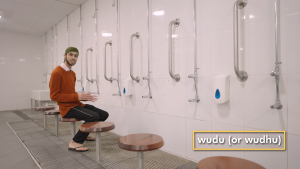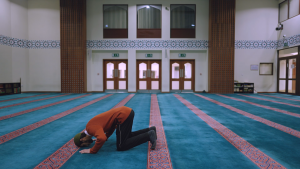Azeen welcomes TrueTube to the East London Mosque and we’re given the full tour. Azeen talks about the features of a traditional mosque and shows us how Muslims pray.
Curriculum Mapping
Component 1: The study of religions: beliefs, teaching and practices – Beliefs and teachings - Islam - Salah and its significance: how and why Muslims pray including times, directions, ablution (wudu), movements (rak’ahs) and recitations; salah in the home and mosque and elsewhere; Friday prayer: Jummah; key differences in the practice of salah in Sunni and Shi’a Islam, and different Muslim views about the importance of prayer. Hajj: the role and significance of the pilgrimage to Makkah including origins, including the Ka’aba at Makkah,
Area of Study 3 – Islam - Section 1: Muslim Beliefs -Salah as one of the Five Pillars, including reference to Surah 15: 98–99 and 29:45: the nature, history, significance and purpose of Salah for Sunni and Shi’a Muslims, including different ways of understanding them; how Salah is performed including ablution, times, directions, movements and recitations, in the home and mosque and Jummah prayer.
Component Group 1–Practices - Islam - Public acts of worship - Salah as direct communication with Allah. The importance of practices - Islam as a way of life, lived in total submission to Allah • The importance of the Five Pillars of Islam to Sunni Muslims • The meaning of the Five Pillars: •• Shahadah: sincerely reciting the Muslim profession of faith •• Salat: performing ritual prayers in the proper way five times each day •• Zakat/Zakah: paying an alms (or charity) tax to benefit the poor and the needy •• Sawm: fasting during the month of Ramadan •• Hajj: pilgrimage to Mecca • The analogy of the house and pillars
2.1 Unit 1 PART A - Part A Islam - Core beliefs, teachings and practices - Practices - The Five Pillars of Sunni Islam -Prayer/ Salat Adhan call to prayer, praying at mosque and Friday Jummah prayer (Qur'an 15:9899, 29:45) Praying at home, private prayer (Du'ah) The preparations and intention for prayer: wudu and niyyah The significance and symbolism of the different prayer positions that make a rakat (sequence of prayer) Obligatory Acts Shahadah: the Muslim profession of faith in Allah and the prophet Muhammad; occasions when the Shahadah is recited, e.g. aqiqah ceremony, conversion to Islam Zakat: paying an alms (or charity) tax to benefit others, what zakat tax may be used for, and additional charity (saddaqah) Sawm: Fasting during the month of Ramadan. How and why Muslims fast during Ramadan and rules about halal and haram diet (Qur'an 2:183)
2.3 Component 3 (Route A) - Option 3: Islam - The Five Pillars of Sunni Islam: practices in Britain and elsewhere - Salah: the practices of prayer in Islam in the mosque and at home, including Jummah prayer: Qur'an 15:98-99, Qur'an 29:45
Transcript
Holy Cribs MOSQUE
Azeen 00:00:14:18
Welcome to the East London Mosque. My name is Azeen. I'm a Muslim. My religion is called Islam. This is where I come to worship Allah, which is what we call God. Come on in. I'll show you around. The inside of the building is always kept clean as a sign of respect to Allah. So the first thing I do is take off my shoes and leave them in these racks here. Girls and women should also cover their heads with a scarf called a hijab inside the mosque. A lot of boys and men like to wear a little cap like this, called a topi. As well as keeping the building clean, we like to keep ourselves clean too. So before I pray, I come in here to do a special wash called wudu. So I sit in front of one of these taps and I wash my hands, face and feet three times. Now I'm ready to go into the main prayer hall. The first thing you notice, there isn't much in here. This building is called a mosque or masjid, which both mean a place of prostration. Prostration is when someone bows down with their forehead right on the floor. And all Muslims do this when we pray, as a sign of complete obedience to Allah. So a prayer hall just needs to be a big open space where lots of people can sit on the floor to say their prayers.
Azeen
00:02:30:13
1/3
Clip: Holy Cribs MOSQUE - FINAL EXPORT 20 March 2023.mp4
Azeen 00:02:36:13
There's nice thick carpet so we're comfortable when praying and there's these lines across it, which we stand on in rows. This gives us enough space to prostrate so we don't bump into the people in front. Wherever we are in the world, all Muslims face the city of Makkah in Saudi Arabia when we pray. That's because the first ever building used to worship Allah, called the Ka'bah, is in Makkah. It's a symbol of togetherness that all Muslims everywhere are concentrating on the same holy place and praying to Allah. The direction of the Ka'bah in Makkah is called the qibla and you can work out using the compass. But here in the mosque there's an easier way. This archway is called the mihrab and it's always in the wall facing the qibla. The person who leads the prayers in a mosque is called an imam, and he'll stand in front of the mihrab to say the prayers out loud. The mihrab reflects his voice back into the room so that everyone can hear him, because, of course, he'll be facing Makkah too. Muslims pray five times a day just before sunrise, just after midday, mid-afternoon, just after sunset and at night before
going to bed. I could do that anywhere, as long as I'm in a clean place or have somewhere to lay down a prayer mat. But lots of people like to come here to pray with other people. About quarter of an hour before the prayer is due to start, a man called a muezzin will call people to prayer by reciting the adhan.
Azeen 00:04:28:18
In Muslim countries, this could be heard from loudspeakers outside so the local people know to stop what they're doing and get over to the mosque. Traditionally, and it's still done in some places, the muezzin will climb the stairs to the top of a tower called a minaret to give the call. Minarets are still a common feature of mosques, even though the muezzin often uses a microphone these days. In the UK, you usually only hear the adhan inside the building. But here at East London Mosque, the daytime calls are broadcasted outside as well. Just before the prayer starts, there's another call which is called the iqamah. On Fridays, people make a special effort to come to the midday prayers because the imam does a special talk called a khutbah,
2/3
Clip: Holy Cribs MOSQUE - FINAL EXPORT 20 March 2023.mp4
and he'll do it from this platform here, which is called a minbar. Above the prayer hall, traditional mosques have a dome. This helps the imam's voice carry to all parts of the room and in hot countries allows the hot air to rise to keep everyone else cool. And some say that the dome is a reminder of heaven above us, and they are often most beautifully decorated. You won't see any pictures of people or animals inside the mosque, because when Islam started in Arabia hundreds of years ago, most people worshipped statues and pictures. So Muslims wanted to show they were different because they worshipped Allah who couldn't be seen. So instead, mosques are often decorated with passages from the Qur'an, which is a holy book, is written in a very old form of Arabic, which looks beautiful when written out like this. The art of beautiful writing is called calligraphy, and some of the oldest and most beautiful calligraphy in the world is in Arabic. You might also see geometrical patterns like geometry in maths. These are amazingly complicated designs made up of different shapes, and they are often symmetrical. Or there are sometimes patterns that look like leaves and branches twining around each other and over the building. That sort of design is called arabesque. Men and women pray separately in the mosque, so they are concentrating on Allah and not on each other. Sometimes the women will have an area at the back of the main prayer hall or a gallery, or like we've got here: the women have their own separate room. Education and learning are very important to Muslims. So we have a classroom here where I come to a madrassah, that's school in Arabic. I'm learning Arabic so that I can read the Qur'an in its original form and not just a translation. And that's my mosque, out here you can see the dome and minaret standing proudly as part of our community. Thanks for coming, bye.
3/3






